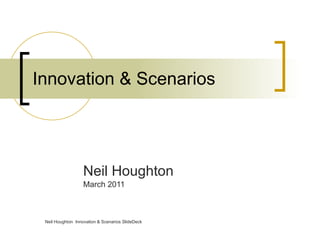iScenarios
- 1. Innovation & Scenarios Neil Houghton March 2011
- 2. Thinking about scenarios Scenario work is actually difficult Why? Because it will involve complexity Social complexity due to the diversity of perspectives Dynamic complexity due to system interdependencies and separation of cause and effect Generative complexity due to uncertainty of emerging and next practices Neil Houghton Innovation & Scenarios ∫›∫›fl£Deck
- 3. Why use scenarios? For many reasons‚Ķ To challenge mental models To create shared learning spaces To enhance resilience of our strategies To surface assumptions To generate understanding and commitment around social problems Neil Houghton Innovation & Scenarios ∫›∫›fl£Deck
- 4. Who? When beginning scenario work ask: Who do you want to be involved? What will they bring? What will they commit to? Who do you need to work with? Who are the ‚Äòproblem-owners‚Äô? Neil Houghton Innovation & Scenarios ∫›∫›fl£Deck
- 5. Stances towards the future Adapt - Anticipate These are two primary stances towards the future Adaptive view: Scenarios as a tool for developing adaptive strategy to respond to possible futures Anticipatory view: Scenarios as a tool for influencing futures Neil Houghton Innovation & Scenarios ∫›∫›fl£Deck
- 6. Discipline Scenario work is a professional discipline There are well developed theories, models, frameworks and history of scenario work Shell 2050 scenarios ( Shell 2050 Scenarios.pdf ) and ( How They Do It.pdf ) South Africa Mont Fleur scenarios ( Mont Fleur.pdf ) Neil Houghton Innovation & Scenarios ∫›∫›fl£Deck
- 7. Characteristics Some key characteristics of scenarios Relevant (addresses a problematic situation) Challenging (addresses a problem of significance) Plausible (may also be potential, possible, probable or preferred) Clear (understandable and insightful) Neil Houghton Innovation & Scenarios ∫›∫›fl£Deck
- 8. Scope of scenario work There are (at least) five purposes of using scenarios You can combine these To create new alliances To create new understandings To create new commitments To create new experiments To create new ecologies Neil Houghton Innovation & Scenarios ∫›∫›fl£Deck
- 9. A generic scenario process Neil Houghton Innovation & Scenarios ∫›∫›fl£Deck New alliances New understandings New commitments New experiments New ecologies
- 10. Example Convening 3 day workshop Making sense 3 day workshop Implications: so what? 3 day workshop Communications 3 day workshop Writing scenarios 3 day workshop Evolution 3 day workshop Neil Houghton Innovation & Scenarios ∫›∫›fl£Deck New alliances New understandings New commitments New experiments New ecologies
- 11. Multiple practices Learning Journeys Systems Thinking New commitments ‚Äò ChangeLab‚Äô & ‚Äò Social Sculpting‚Äô Models of Change Signature Practices Innovation Labs Neil Houghton Innovation & Scenarios ∫›∫›fl£Deck
- 12. Multiple typologies There are multiple forms of scenarios Trajectories Ranges 4 Worlds Branches Horizons etc etc Neil Houghton Innovation & Scenarios ∫›∫›fl£Deck A A ‚Äô A A ‚Äô A ‚Äô‚Äô A 1 A 2 A 4 A 3 A A ‚Äô H 1 Issue - Horizon H 2 H 3 I 1 I 2 I 3
- 13. Innovation front-end There is a front-end to innovation and scenarios play a key role as variety and novelty-generators Neil Houghton Innovation & Scenarios ∫›∫›fl£Deck













